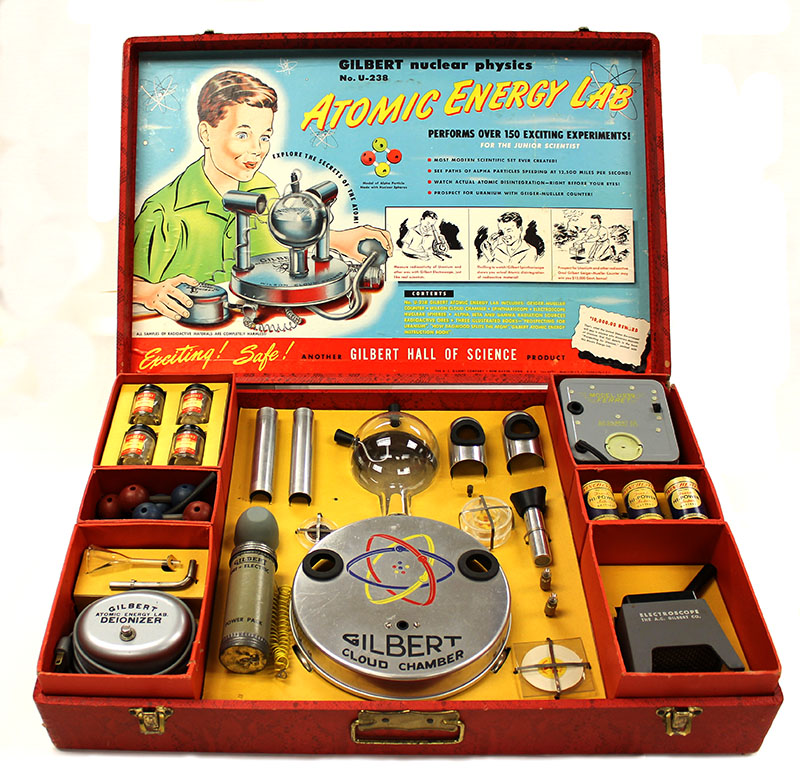
When you think of the word “nuclear”, what’s the first image that comes to mind?
An atom stamped on a 1950’s-style science textbook?
How about a happy boy of yesteryear playing with an Atomic Energy Lab (to the vast bemusement of future generations)?
Or, does the mind go to a darker place — recalling scenes from the intriguing (yet woefully unscientific) HBO miniseries Chernobyl?
Or maybe, you’ve seen the more optimistic, science-forward, trendy videos by model-turned-nuclear-activist, Isodope. (If you haven’t, definitely check them out!)
Representations of nuclear energy in popular culture vary widely, and we all know it can be a pretty divisive topic. At the same time, climate scientists have been sounding the alarm for decades with a clear message: without safe and expanded nuclear power, humanity will struggle to meet the Paris Agreement’s goal of keeping global warming under 2 degrees Celsius.
And yet, nuclear plants are increasingly getting shut down, years ahead of schedule, and being replaced with fossil fuels— despite the fact that this method of producing energy is literally killing us. The World Health Organization reports that at least one-third of deaths from strokes, lung cancer, and heart disease are caused by air pollution, fueled by fossil fuel energy production. So, why get rid of nuclear plants when keeping them can mean saving lives?
That vexing question is precisely why SpaceshipOne has partnered with Got Nuclear? to help launch their advocacy project:
In 2019, Americans were still evenly split on whether nuclear energy is a good idea. Part of the reason is our conditioned fear response to nuclear’s hyped-up associations with meltdowns and weapons. But here’s some good news: in 2020, 57% of Americans favored further investment in research and development for modern nuclear reactors. This shows us more people are likely to be supportive if they’re aware of the advancements being made in reactor technologies— and how those could provide lasting, direct benefits to our climate and our health.
So, let’s dive into what nuclear energy is, exactly; why we need it; what its risks are; how much it can cost; and how nuclear fits into broader plans for bold climate action.
What is Nuclear Energy?
A good place to start is by answering a related question: where does [most of] our electricity come from?
Most electricity is generated by burning either coal or natural gas. The heat boils water to drive turbines, creating electrical current. Burning the fossil fuel creates a chemical reaction, where its chemical bonds rearrange so that the byproduct is primarily water and carbon dioxide gas.
We can also generate electricity by producing a nuclear reaction, which actually releases millions of times more energy than a chemical reaction. In a nuclear reaction, a small amount of mass gets converted into energy in the form of heat. We can create a nuclear reaction either by splitting heavy elements (like uranium) into smaller pieces, or by fusing together light elements like hydrogen and deuterium.
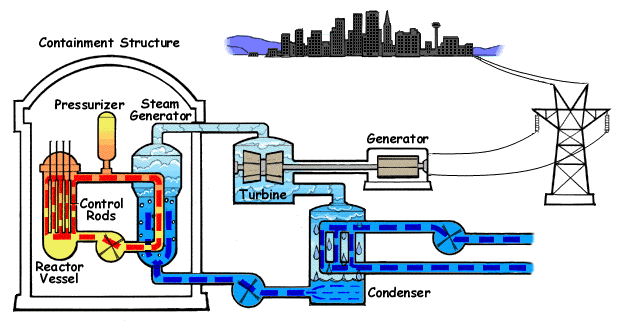
The reactors used in most nuclear plants today are fission reactors. In a fission reactor, the nuclear reaction sustains itself through a chain reaction process that produces heat, which combines with a reactor’s cooling agent to create steam. The steam makes turbines move, which drives a generator, which creates electricity.
Nuclear Energy is Clean Energy
Around the world, people’s livelihoods, quality of life, and life expectancy are threatened, increasingly, by air pollution and climate change. While the situation is dire, let’s keep in mind: our air would be likely far more polluted, our climate changing far more rapidly, and our lives more at risk if we did not have nuclear energy to displace fossil fuel energy production (even partially).
Nuclear power plants release zero greenhouse gas emissions or particulate matter. And, from uranium mining to reactor construction, nuclear ranks among the lowest in life-cycle emissions compared to all other energy sources. Over half of the United States’ emissions-free electricity is generated by nuclear power stations, and in an average year, they prevent hundreds of millions of tons of CO2 from being spewed out— more than all other clean energy sources combined!
When nuclear plants get shut down (or don’t get built in the first place), fossil fuels tend to replace them. Renewables can’t, in most cases; we still need power when the sun doesn’t shine or the wind doesn’t blow, and nuclear (as well as coal, oil, and natural gas) can meet demand more reliably. Battery storage solutions, while promising, are not yet ready for large-scale deployment. (Not to mention, the average solar farm uses about 75 times more land area than a conventional nuclear plant to produce the same amount of electricity; wind farms use up to 360 times more land!)
Of course, we need a mix of clean energy sources, each with its own pros and cons, to be able to ensure clean air and make progress towards climate restoration. Scientists and experts agree that a swift transition to 100% clean energy is necessary— and that nuclear energy is a key piece of the puzzle!
Nuclear Energy Is Safe (One of The Safest, Actually)
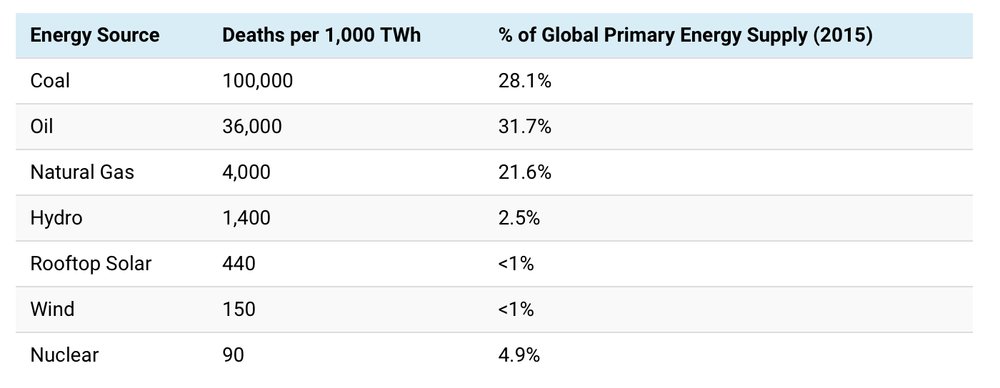
With all the anti-nuclear hysteria out there, it might be surprising to discover the truth: that nuclear is actually one of the safest energy sources (if not ,the, safest) in the world. Not only has nuclear prevented millions of deaths that would’ve otherwise been caused by fossil fuels, the deaths that it has caused (as a result of accidents) have been relatively few and far between. Nuclear ranks among the lowest in deaths per unit of energy produced, with roughly one death every fourteen years, in the worst case.
Of course, a death rate is an extreme metric, and not the only way to measure safety. For example, many people are concerned about nuclear waste and radiation. It’s good to ask questions, and even better to understand the answers in their broader context: while nuclear is far from perfect, its likely alternative is far, far worse. Fossil fuel air pollution kills millions of people per year and brings chronic illness and disease for millions more. Not to mention climate change, which will cause untold human suffering if we don’t make big changes, like the clean energy transition, within this decade.
But, back to nuclear. It has the power, literally, to help us get there. So let’s review some facts about radiation, used fuel, and accidents. (The more you learn about nuclear, the less scary it is. We promise.)
What About the Radiation?
As far as radiation goes, the first and foremost thing to know is: it’s a natural phenomenon, happening all around us at all times, at varying levels. It’s in the Earth’s minerals & soils; in the skies as cosmic rays; and in our own bodies. Simply sleeping next to someone else exposes us to radiation!
More facts about radiation that may surprise you:
• Eating a banana (which contains potassium-40 isotopes) exposes you to more radiation than living near a nuclear plant for an entire year.
• The amount of radioactive elements emitted from coal plants (in the form of fly ash) is greater than those from nuclear plants.
• The highest exposures people have to radiation are from X-rays, medical diagnostics, and nuclear medicine (not nuclear energy).
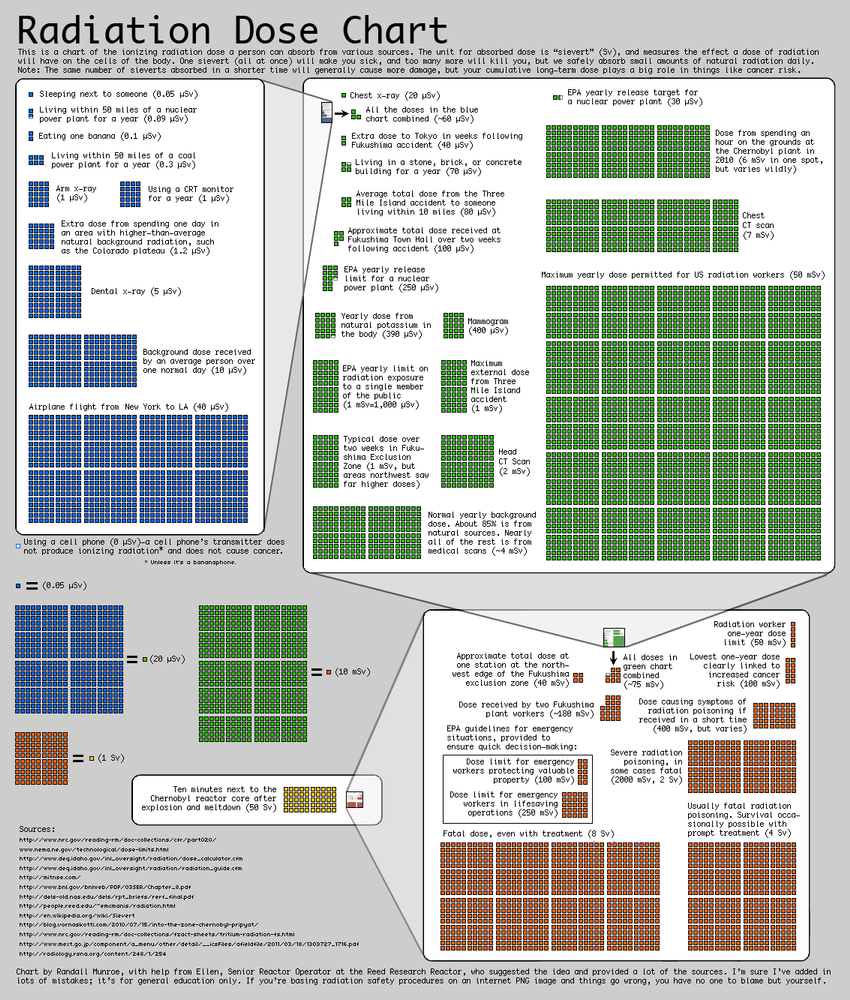
What About the Waste?
Like fluffy feathered dinosaurs, this is one of those things people don’t want to admit because the truth just isn’t as exciting. Contrary to popular belief, nuclear waste is not some evil green liquid oozing everywhere and spawning superheroes. Nope. In fact, nuclear waste is tiny and solid.
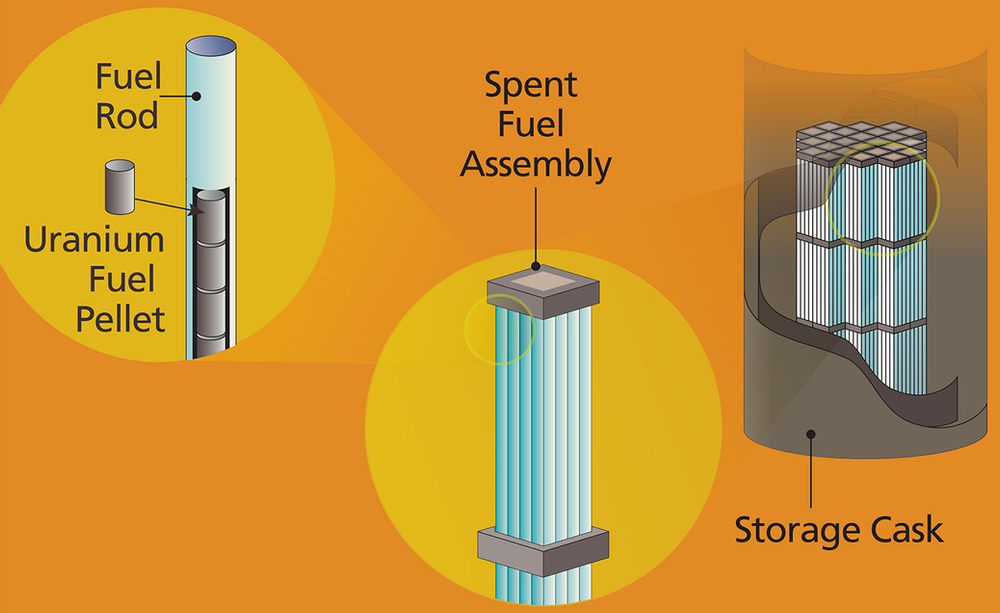
The entire “dump” produced by the U.S. since the 1950s can fit in a single football field. (Compare that to the destruction wrought just by mountaintop removal — a form of coal mining that has obliterated a cumulative area the size of Delaware and poisoned nearby towns with cancers, respiratory disease, and birth defects.)
The small amount of nuclear waste that does exist can be recycled into fuel for modern nuclear reactors. Generation IV reactors, such as the molten salt reactor, which uses salts as a coolant instead of water, are designed to be safer and more efficient than the old guard— and, yes, they eat nuclear waste!
As for shipping this stuff (whether for fuel or storage): to date, there has been no spill or exposure that has put anyone or anything at risk. Americans’ hyped-up fear about nuclear waste or other safety issues has been going down in recent years, and a majority of us are in favor of modern reactors.
What About the Accidents?
The idea of smashing the very building blocks of matter is pretty cool. We’re Godzilla, and atoms are the Lego city our brother made. But is this immense power something we should really be messing with?
Just in case you’ve been living under a rock and haven’t heard of Fukushima, Three Mile Island, or Chernobyl, let’s pause here to look at the worst that humanity’s use of nuclear energy has wrought on our world.
Fukushima
In 2011, a tsunami hit Japan’s Fukushima Daiichi Nuclear Power Station, exploding parts of it and releasing radioactive materials into the surrounding environment. About 600 people died due to the conditions of the evacuation, and many continue to suffer from psycho-social impacts to this day. And while one person did die from radiation exposure, the majority were exposed to less than a third of what the average person picks up in a year under normal circumstances.
Three Mile Island
The most serious nuclear accident in U.S. history occurred at Three Mile Island in 1979. This partial meltdown deeply frightened the entire country and redefined U.S. nuclear safety and oversight. So, how bad was it? Monitoring teams collected thousands of samples from the area, scrutinizing everything from the air to milk and food. They found little effect on neither the environment nor human health. The two million people closest to the damaged reactor were exposed to about 1/6th of the radiation you’d get during a chest X-ray.
Chernobyl
In 1986, an accident at the Chernobyl nuclear power plant (located in modern-day Russia) spread radiation throughout three countries. An evacuation prevented severe harm to the most at-risk population, and though 134 emergency workers tragically died, the five million residents of the contaminated areas received very little exposure.
Still, Chernobyl was a disaster that caused significant harm to the people of the region. In the following decades, about four thousand people found out they had thyroid cancer from drinking contaminated milk as children during the time of the accident. Also, recent studies have shown a rise in leukemia among people who were exposed to very high doses, such as emergency responders and recovery workers.
When discussing nuclear energy, there is no question: the accident at Chernobyl hurt people, and we cannot downplay or look away from that. Learning from mistakes is what helps us build a safer, healthier, more prosperous future.
It’s also beneficial to keep the incident in perspective, and view nuclear in its broader energy context, alongside fossil fuels. For example, more lives have been lost in coal mining accidents in the last ten years than the total lost due to Chernobyl (the worst nuclear accident in history).
Nuclear Energy Is Reliable (The Most Reliable, In Fact)
Nuclear plants run at full capacity about 93% of the time — the highest rate of any energy source. That means they’re producing the greatest amount of energy possible, 24 hours a day, seven days a week, for 340 days out of the total 365 days in a year. Pretty awesome, right?
(Bonus fun fact: nuclear is also reliable as a job. Worldwide, the nuclear industry employs about half a million people, who enjoy job security while earning higher salaries than their local averages.)
Nuclear Energy and Renewables
The fact that humans can harness the raw power of the sun and the wind to make electricity is pretty amazing. But, here’s the thing: solar panels don’t work without sunlight, and wind turbines don’t spin without wind.
Unfortunately, these renewable energy sources can’t output energy on demand, as other sources (like nuclear) can. By 2024, it’s expected that emerging technologies will allow for the storage of over 5.4 gigawatts in the U.S., which would be great— except we need about 25 times that to get even 80% of our electricity from renewables.
A stable electricity grid, especially in the near future, requires a baseload power source with the ability to output electricity day or night, gale or doldrums. The U.S. uses a combination of nuclear and fossil fuels to provide baseload power, but many nuclear plants are getting retired early, and they aren’t being replaced with renewables; most often, fossil fuels (especially natural gas) take their place.
Nuclear plants have 1.5 – 2 times the capacity of fossil fuel ones, so for every nuclear plant that gets shut down, we’re most likely adding the equivalent of 1.5 to 2 new fossil fuel plants— dumping tens of millions of tons of CO2 into our warming atmosphere. That’s why it’s so important to advocate for no more nuclear plant closures, so the reactors can continue to provide us with loads of clean, reliable energy.
The Price Tag
Nuclear is more expensive than most other energy sources… at least, it is in the United States. In Asia, it tends to be about half the cost. Why the huge difference?
One reason is the US government’s poor management practices when working with the nuclear industry. For example, they’ve allowed plant construction to start before its design is complete, and have failed to include construction experts or fabricators on the design team. But even with proper oversight and foresight, the process of building massive, complex, custom nuclear reactors can be inherently difficult to do cost-effectively.
That’s why small modular reactors (SMRs) like these are becoming so popular. They total about $3 billion per plant— less than ,half, the cost of a traditional nuclear reactor. SMRs are designed to fit together from pre-fabricated, standardized parts that are mass-produced in a factory. The design is approved once. The modules are shipped to each site and fit together with comparatively minimal effort. The result? An adorable little baby nuclear plant that’s far cheaper, and also safer, than its big brother.
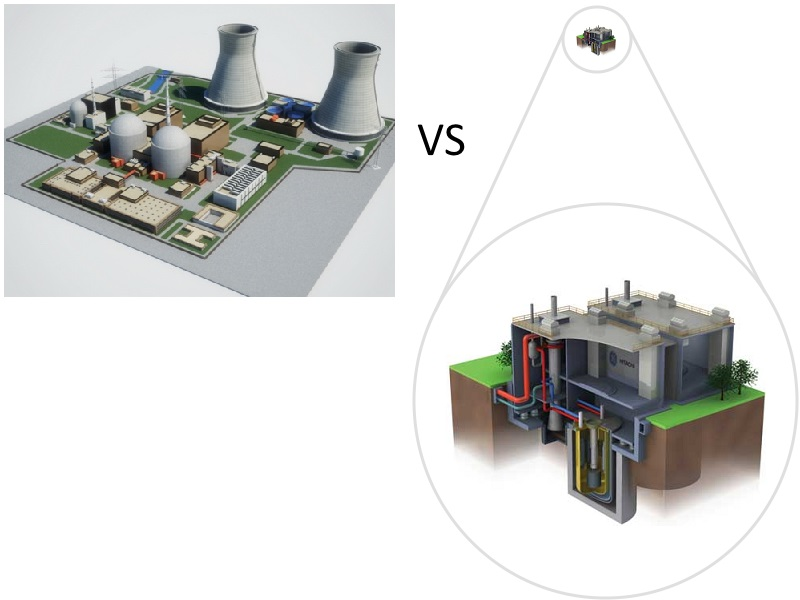
Expectations for the New Administration
According to President-elect Joe Biden, the Green New Deal (GND) “will pay for itself” and “is a crucial framework for meeting the climate challenges we face”… but he also does ,not, support it. The GND has become a tribalistic marker for one’s allegiance to or hatred of the political left, and the President-elect intends to forge solid policy while avoiding political feuds.
The Biden Plan intends to make U.S. electricity generation carbon-free by 2035, with zero emissions by 2050. The plan earmarks $2 trillion for clean energy, including the development of small modular reactors and an agency devoted to affordable clean technologies. The agency should help the U.S. achieve Biden’s clean energy target by pursuing, among other things, advanced nuclear reactors.
